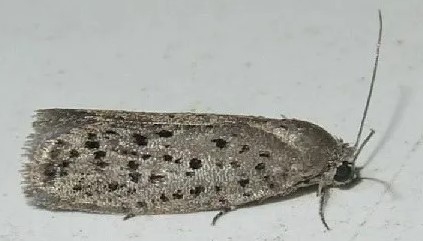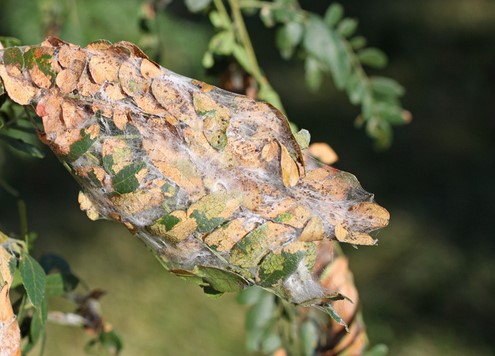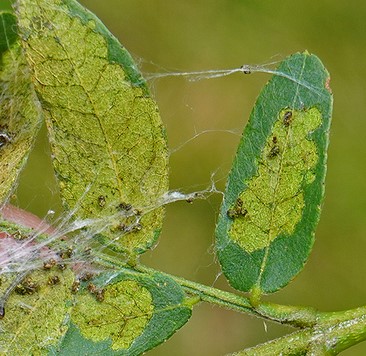The Honey Locust Tree and the Mimosa Webworm Battle
by Elaine Pugh, Fairfax Master Gardener

Mimosa webworm
Like a wave, it started. The tips of the Gleditsia tricanthos var. inermis, the thornless honey locust trees along the main street of my neighborhood, turned reddish brown, followed by the trees on our parallel street, my neighbor’s tree and then mine. Matted webs are on the branch ends with streams of silk threads raining down from my tree, with a small, thin worm-like caterpillar at the end of each strand. The culprit — the mimosa webworm.
Homadaula anisocentra, the mimosa webworm, is a caterpillar/moth pest that mainly attacks honey locust and mimosa trees. Honey locust trees are important because they are valued for their fine textured leaves and light shade providing character in the landscape. Mimosa webworms are small, up to 1 inch long (3 cm), slender caterpillars, grayish to dark brown, sometimes tinged with rose or pink, with a brown head and five white stripes that run the length of the body. They are extremely active, and will drop on silk strands when disturbed, with the goal of reaching the ground to attach to a surface and spin cocoons. The adult mimosa webworm moths emerge as steel-gray moths with a silver sheen and small black dots on their forewings and a one-half inch wing span.

Mimosa Webworm adult moth
The mimosa webworm pest seemed to come to my tree in a wave. However, the wind did not send these tiny caterpillars into my yard. These pests overwinter inside white, silken cocoons in groups as slender brown pupae in mulch, on tree trunks or some other sheltered area on the soil or other surfaces. The following June, the moths emerge and mate.
The females fly up into the trees and lay many eggs on terminal leaves and flowers and small twigs on the trees. The slender caterpillars that emerge feed gregariously within a web spun over the end flowers and leaves as they feed, giving the branch tips a red burnt look. Then they slide to the ground on silk stands to pupate on the ground. And the cycle continues. We have two generations of mimosa webworms a year. Another generation of moths emerges a short time later. The second generation of caterpillars are active during August and early September.

Webbing at end of branch
The caterpillars feed gregariously on the leaf surfaces, skeletonizing the foliage and webbing leaves and flowers at the end of the branches. They work together within webs spun over the foliage at the ends of the branches as they feed and develop. They only feed on leaflets enveloped by their silk nests. The lower epidermis is usually entirely destroyed. Leaves die and turn as if fire-scorched. Leaves and leaflets are so tightly encased in webbing that the foliage looks like it’s melting.
The mimosa webworm was first found in the US in the 1940s in Washington, D.C. These pests have since spread throughout the eastern United States and Canada and as far west as Texas and Nebraska.
Controls
Encourage natural predators, parasitic wasps and other insects and birds to feed on the caterpillars.
Cultural and Mechanical Controls
- Clear away leaf debris, pull down the webs and drop caterpillars in soapy water.
- Use less susceptible honey locust varieties, Gleditsia tricanthos): ‘Moraine,’ ‘Skyline,’‘Shademaster’ and ‘Imperial.’ ‘Sunburst’ is very susceptible.
- Do nothing. Otherwise healthy trees can withstand one or even a few years of total defoliation. However, repeated caterpillar feeding can damage a tree’s long-term health and even kill the tree.
Chemical Controls
The following pesticides are listed as acceptable to use to control Mimosa Webworm in Virginia: Avermectin B1, Bacillus thuringiensis (Bt), Bifenthrin, Carbaryl, Deltamethrin or Pyrethrins.

Epidermis leaf damage
According to the North Carolina Extension Office, if treatment is made in the spring while the honey locust trees are in bloom (sometime from May through June), it would probably be better to use Bacillus thuringiensis insecticides for control rather than a synthetic organic pesticide to avoid killing bees. Later in the season, those insecticides labeled for residential landscape use should give more than adequate suppression.
Timing of pesticide treatment: Apply foliage sprays at 4- to 5-day intervals immediately after the first sign caterpillars are seen feeding, usually in June, until the infestation is controlled. Many eggs are laid initially and the young larvae begin to feed extensively. Larvae are more difficult to control when larger and webbing is extensive.
As always, handle insecticides with care. Follow directions on the label. Keep insecticides off the skin and out of eyes, nose and mouth. Wash immediately with soap and water if concentrates are accidentally spilled on the skin. Store unused insecticides in a dry area, out of the reach of children and pets.
- References
- Mimosa Webworm, Eric Day, Virginia Cooperative Extension
- 2024 Pest Management Guide — Home Grounds and Animals, Table 4.6, Control Measures for Major Pests and Pest Groups, Mimosa Webworm, Virginia Cooperative Extension, 456-018
- Mimosa Webworm, PDIC Factsheets, North Carolina State Extension
- Mimosa Webworm, Michael J. Skvarla, Penn State Extension
- Mimosa Webworm on Honey Locusts, Joe Boggs, The Ohio State University Extension